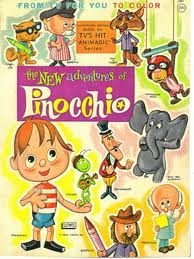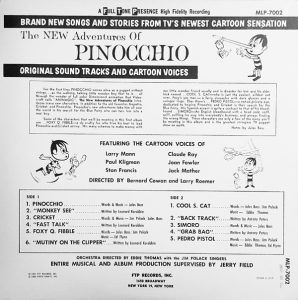Rankin/Bass’ “New Adventures of Pinocchio” on Records | (original) (raw)
It’s no lie: this is the obscure soundtrack to the first TV show to use the stop-motion “Animagic” process, years before Rudolph, Frosty, the Snow Miser and the Heat Miser.

Brand New Songs and Stories from
TV’s Hit “Animagic” Series
THE NEW ADVENTURES OF PINOCCHIO
Original TV Soundtrack and Cartoon Voices
FTP Records MLP-7002 (12” 33 1/3 RPM / Mono)
Released in 1961. Album Producer: Jerry Field. TV Series Producer: Arthur Rankin, Jr., Co-Producer: Jules Bass. Directors: Bernard Cowan, Larry Roemer. Conductor: Eddie Thomas. Character Design: Anthony Peters. Liner Notes: Jules Bass. Running Time: 33 minutes.
Voices: Joan Fowler (Pinocchio); Stan Francis (Gepetto); Larry D. Mann (Foxy Q. Fibble), Paul Kligman (Cool S. Cat); Claude Ray, Jack Mather (Additional Voices); The Jim Polack Singers. Stories: “Monkey See,” “Fast Talk,” Mutiny on the Clipper,” by Leonard Korobkin; “Back Track,” Grab Bag” by Anthony Peters.
Songs: “Pinocchio (Theme),” “Simoro” by Jules Bass; “Cricket” by Jim Polack, Jules Bass; “Foxy Q. Fibble” by Jules Bass, Jim Polack, Ed Flynn; “Cool S. Cat” by Jules Bass, Jim Polack, Eddie Thomas; “Pedro Pistol” by Jules Bass, Jim Polack, Eddie Thomas, Ed Flynn.
 The New Adventures of Pinocchio was the first Rankin/Bass TV series (under the original name, Videocraft International), four years before Rudolph, the Red-Nosed Reindeer brought the company into prominence in holiday specials and King Kong made them a contender in Saturday morning TV.
The New Adventures of Pinocchio was the first Rankin/Bass TV series (under the original name, Videocraft International), four years before Rudolph, the Red-Nosed Reindeer brought the company into prominence in holiday specials and King Kong made them a contender in Saturday morning TV.
The late’50s/early ’60s were the era of five-minute syndicated cartoons with the flexibility for use in local children’s live-action variety shows, grab bag cartoon clusters and sometimes in their own dedicated half-hour. From Hanna-Barbera’s Ruff and Reddy and King Features’ Popeye to UPA’s Mister Magoo and Dick Tracy, these cartoons were churned out in the hundreds, sometimes produced in several studios at once throughout the world.
The stop-motion process for Pinocchio—animated mostly on “two’s’ and “three”s that Rankin and Bass dubbed “Animagic”—was contracted by Dentsu in Japan, which is also the world’s largest advertising agency (the roots of Rankin as an art director and Bass as a copywriter were in advertising and promotions). Bernard Cowan, who cast and directed all of Rankin/Bass’ Canadian voice sessions–and served as announcer for this series and several others–brought in actors like Stan Francis as Gepetto and Larry Mann as Foxy Q. Fibble, later casting them as Santa and Yukon Cornelius, respectively, in Rudolph.
This album is pure gold if only because of all the early names involved that figure into Rankin/Bass history. Larry Roemer directed the series as well as Rudolph and several other R/B projects. Tony Peters, credited as a writer on the album, was production designer for Rudolph. Another writer, Len Korobkin, co-wrote the Mad Monster Party screenplay.
 Also pivotal is Forrell, Thomas and Polack, a New York music production house that supplied songs and backgrounds for commercials, TV shows and records. In addition to its work on the Pinocchio series and this album, FTP handled the songs and music for Willie McBean and His Magic Machine, the first Rankin and Bass feature film. As Rick Goldschmidt chronicles in his book, The Enchanted World of Rankin/Bass, the last five episodes of Pinocchio are actually a pilot pitch for an unsold series with a character called Willy Nilly, who evolved into Willie McBean.
Also pivotal is Forrell, Thomas and Polack, a New York music production house that supplied songs and backgrounds for commercials, TV shows and records. In addition to its work on the Pinocchio series and this album, FTP handled the songs and music for Willie McBean and His Magic Machine, the first Rankin and Bass feature film. As Rick Goldschmidt chronicles in his book, The Enchanted World of Rankin/Bass, the last five episodes of Pinocchio are actually a pilot pitch for an unsold series with a character called Willy Nilly, who evolved into Willie McBean.
For the Firestone tire company, Forrell, Thomas and Polack produced the few two albums in the “Your Christmas Favorites” LP series. The arranger/orchestrator for these albums was Maury Laws, whom FTP brought in to performed similar duties on the NBC prime time special, Return to Oz. The producers of this special were Rankin and Bass, who were so impressed by Laws’ work, they made him the musical director for Rudolph. Soon he was partnering with Jules Bass for almost every Rankin/Bass production, starting with the 1966 theatrical feature, The Daydreamer.
As a series, The New Adventures of Pinocchio is more verbose than one might expect, offering comedy and fantasy for kids with gentle satire for adults. The results vary, it’s not as biting as Jay Ward but it’s more acerbic than Hanna-Barbera. There are nods to era-specific things like the beat generation and the space program. It’s also notable interesting that, in its 130 episodes, the stories touched on several themes that would serve Rankin/Bass in subsequent cartoons, such as monster spoofs and the Pinocchio story itself (which reemerged in the 1980 special, Pinocchio’s Christmas).
GIVE A LITTLE LISTEN
“The New Adventures of Pinocchio”
Rather than covering just one five-episode story arc, the soundtrack album includes one segment from five different arcs. Narrating as Gepetto, Stan Francis’s performance is more genial than the somewhat cranky Santa he played in the Rudolph special. FTP produced five original songs for the album. Jules Bass wrote both the lyrics and the music for the title tune. Maury Laws would later be the primary composer with Bass as lyricist.